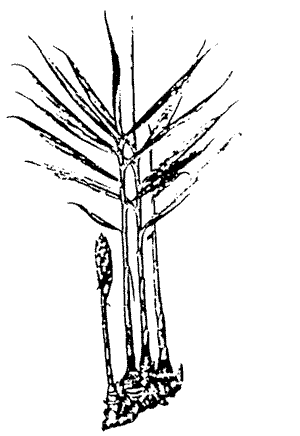
GINGER
SCIENTIFIC NAME: Zingiber officinale
FAMILY: Zingiberaceae
The familiar and useful ginger is the rhizome or underground stem of Zingiber officinale roscoe, a perennial reed-like plant growing to a height of 90-120 cm. The flowers and leaves are borne on separate stems. The flowers themselves are borne at the apex of the stem in a dense, ovate, oblong, cone-like spike from 5-7cm long. The plant, though unknown in the wild state, is considered with very good reason to be a native of warmer parts of Asia. It needs heavy rain and plenty of sun, a warmer moist tropical climate and a situation up to 850 above sea level.
Propagation is by dividing the rhizomes into pieces 5cm long. The ginger is ready to harvest nine months to one year after planting, when the plant begins to wither. The rhizomes are dug up with a hoe. The familiar spice is obtained from the rhizomes, which are marketed fresh, dried, ground and preserved.
Ginger can be traced back to very early times. It was thought that the Greeks and Romans were the early importers of this herb from Arabia as it was received via the Red Sea. But the spice has been traced back to before the first century and it was found in Alexandria, with other Indian spices.
Ginger has many uses, both medical and in cooking. Use it in stews, sauces, grated and ground for gingerbread cakes, mulled wine, liqueurs and cordials. Preserve the green roots in a syrup. Chew the root to soothe a sore throat. Recent research has confirmed that an infusion is excellent to settle the stomach and prevent nausea when travelling.
GROWING GINGER IN THE HOME GARDEN
To produce good quality ginger, cultural practices, time of planting and harvesting are fairly exacting. The garden soil should be loose and friable, offering minimum resistance to the development of the ginger rhizome. Good drainage is important as the plant will not tolerate waterlogging. The garden bed should receive maximum amount of sunlight and be sheltered from hot, drying winds.
Preparing the bed
The garden bed should be prepared in winter. Well-rotted animal or poultry manure is very beneficial. An application of lime or dolomite may be necessary to raise the soil pH to the most favourable level of 6.0. The soil is formed into beds approximately 150mm high and 1.5 meter wide to accommodate four rows of plants.
Planting Material
Portions of the rhizome, 'seed-pieces', are used as planting material. A piece weighing between 50 and 80 grams is recommended. Care being taken to leave at least one eye or bud on the cutting. The cut pieces should be allowed to heal before planting to reduce the possibility of fungus infection Seed can be purchased from a supermarket where it is sold as green ginger.

Planting
September is the best time to plant. This allows the plant to become well-established before the onset of hot weather from October to December when plants are subject to sunburning. The seed pieces are normally planted at 150 to 200 mm intervals and covered with 25mm of soil.
Fertilising and Mulching
A complete fertiliser mixture containing 10% nitrogen, 4% phosphorus and 6% potash should be applied. The fertiliser can be broadcast over the beds, or drills are opened up along the proposed planting rows and the fertiliser is then covered with soil. Ginger benefits from regular side dressings of nitrogen. Apply regularly 10 grams of urea per square meter and water in immediately.
The ginger may be mulched with sawdust or blady grass. Mulching conserves soil moisture, it controls weed growth and the rhizomes are clean with a soft peel when harvested. The mulch is applied as soon as the seed is planted. Sawdust should be spread 75 cm thick and blady grass about double this thickness.
Watering
The soil should be watered after planting and before any mulching material is applied. Water regularly but don't overwater. When sunburning weather occurs, 50% shadecloth may be erected during the hot period in October, November and December.
Harvesting
The ginger is carefully dug out with a garden fork and the tops trimmed. The rhizomes are then scrubbed with a stiff brush. Usually the rhizomes are harvested in June or July and hung in hessian bags in the shade under shelter until required.
DATE: March 1994
* * * * * * * * * * * * *
